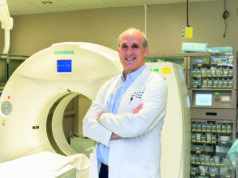 Scott Trerotola, Stanley Baum professor of Radiology and chief, Vascular and Interventional Radiology, University of Pennsylvania Medical Center, Philadelphia, USA, discussed how competition improves interventional radiology, while delivering the Dr Charles T Dotter Lecture at the 2016 Society of Interventional Radiology (SIR) annual meeting in Vancouver, Canada.
Scott Trerotola, Stanley Baum professor of Radiology and chief, Vascular and Interventional Radiology, University of Pennsylvania Medical Center, Philadelphia, USA, discussed how competition improves interventional radiology, while delivering the Dr Charles T Dotter Lecture at the 2016 Society of Interventional Radiology (SIR) annual meeting in Vancouver, Canada.
“Medicine is [also] a business, compete. Competition makes us better—be the competitor,” Trerotola said. He further explained that while there is no “IR” in the word “turf”, there certainly is in “competItoR”. “The history of interventional radiology is filled with competitive successes including venous access, uterine fibroid embolization, venous ablation, interventional oncology and much more,” he outlined.
Trerotola then took the example of peripheral arterial disease interventions, which most interventional radiologists feel that they have lost out in to other specialists.
“I am going to make the assumption that peripheral arterial disease treatment, is something most of us want to do more of, therefore we have to compete for it,” he said.
“Some 25 years ago, I would argue that we were not fully ready to compete in peripheral arterial disease. At that time, we had a monopoly on peripheral arterial disease work, […] we thought we owned it […] yet growth of peripheral artery disease was stifled by lack of uptake by vascular surgeons, [… and] there was little uptake of this limb sparing approach.
The endovascular revolution forever changed the perspective of peripheral arterial disease interventions, especially infrainguinal ones,” he continued.
Although, this enabled the peripheral arterial disease “boat to float” and take off, interventional radiologists were not in it. “Sometimes in competition you lose, you cannot take it personally,” urged Trerotola.
He then referred to quotes from Bruce Brown’s book for young athletes that had some good messages on competing: one was “win or lose, you bounce back and go after it again.” Another key message was that the best competitors “recover quickly”.
“I will submit to you that peripheral arterial disease can, and will be a big part of interventional radiology’s history. It is there for the taking—all we have to do is roll up our sleeves and compete,” Trerotola said.
He said his department followed the mantra of “play, recover, play” and that his colleague at Penn, Timothy Clark, had applied a model many times over to successfully compete for peripheral arterial disease work. The model, Trerotola noted, is based on being “clinically strong, talented, aggressive, available and willing.” He explained that while Penn had suffered the same decline in peripheral interventions as other practices had in the year 2000, they now saw a sharply rising graph of the number performed by interventional radiology.
“The industry is taking notice and there is substantial rapprochement as they realise we are players in peripheral arterial disease. This is happening at the national level as well. Interventional radiologists are competing for peripheral arterial disease work, and doing so successfully,” he said.
Interventional radiology’s role in peripheral interventions
Commenting on the historical role of interventional radiologists treating peripheral arterial disease in the USA, James Benenati, medical director, Peripheral Vascular Laboratory, Miami Cardiac and Vascular Institute (MCVI), Miami, USA, told Interventional News: “Early on, interventional radiologists in the USA performed most of the peripheral vascular interventions. Although we were well trained technically, we were not trained to clinically manage patients, market ourselves and build a practice. When other specialties came along, it became very competitive and we lost a considerable amount of our market share. But now, with our new training standards and a renewed interest in peripheral arterial disease interventions, interventional radiologists are making a strong comeback into this area. We are still a very innovative specialty and there is a lot of intellectual property related to peripheral arterial disease that is developed by us. Most importantly, we can now manage and clinically care for our patients, so it is possible to compete with the other specialties and provide outstanding care before, during and after, these interventions.”
Benenati, programme director of MCVI’s fellowship programme in interventional radiology, which is accredited through the Accreditation Council for Graduate Medical Education and a past president of SIR, stated that it was estimated (through survey data and conversations with the industry) that interventional radiologists still control 20–25% of peripheral arterial disease interventions (with the rest of the US market share estimated to be broken down as 50% performed by vascular surgery and 25% by interventional cardiology). “Although, the interventional radiology share is not a majority, the scope of peripheral arterial disease interventions has grown tremendously and the number of patients being treated is much higher than it was twenty years ago. So, although the percentage is down, the actual number of people being treated by interventional radiologists has grown,” he explained.
“Competition is always healthy, as long as the playing field is level. Through this competition, interventional radiologists have also recognised our weaknesses and improved ourselves. We now deliver a much better quality of care. The current impediment we have is the challenge of enabling diagnostic radiologists who are largely involved in reading films to understand the value of practice building and clinical care—that is currently our main challenge, not that cardiologists or surgeons who are carrying out these procedures,” said Benenati.
European perspective
“We have seen that interventional radiologists lost out in peripheral arterial disease treatment, particularly in the USA, but this does not hold true so much in Europe and in other parts of the world. While interventional radiologists treat about 25% of peripheral arterial disease patients in the USA, this number is much higher in parts of Europe, particularly in Germany,” said Michael Lee, consultant interventional radiologist and professor of Radiology, Beaumont Hospital Radiology Department, Dublin, Ireland.
Explaining, Lee said: “In the USA, it is a fee-for-service system, so there is intense competition for cases. On the other hand, in Europe, health systems are predominantly social systems run by National Governments rather than a purely private healthcare system. Moreover, the funding of healthcare and the business model for procedural specialties varies widely from country to country. However, in many countries tariffs for interventional and surgical services are being introduced, which will certainly lead to more competition for endovascular intervention.”
“We know that cardiologists have the skillset to treat peripheral arterial disease by endovascular means and vascular surgeons are acquiring the skill set. We believe that the person carrying out endovascular procedures should be appropriately trained and have their training certified in the best interest of patients. There should also be a level playing field in terms of training and accreditation with properly developed curricula, an appropriate number of first operator procedures and robust certification of competence,” he added.
Lee, a past president of CIRSE and chair of the CIRSE Task Force on peripheral arterial disease intervention, emphasised: “In Europe, we are currently trying to evaluate which specialties are carrying out which peripheral interventions and what access to clinical practice interventional radiologists have. Clinical practice is the most important aspect of increasing visibility and recognition for interventional radiology and European interventional radiologists need to fully embrace clinical practice, or lose market share in the increasingly competitive field of endovascular intervention. Interventional radiologists need to become clinicians: see patients; treat patients; and admit patients. Interventional radiologists in the USA who have embraced clinical practice have survived the onslaught of competition in the peripheral arterial disease space.”
The CIRSE Task Force, which consists of nearly a dozen experienced interventional radiologists from different countries in Europe, is trying to achieve certain key goals. These include ascertaining the number of interventional radiologists currently doing peripheral arterial disease work, understanding what kind of clinical practice they are engaged in, as well as documenting the financial model they are using.
“Ultimately, we want to make sure that interventional radiology continues to have a serious foothold in future peripheral work. We want to make a strategic plan for the next 10 years to ensure that interventional radiologist have the tools, knowledge and information necessary to be a player in peripheral arterial disease treatment,” Lee concluded.










